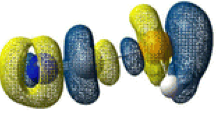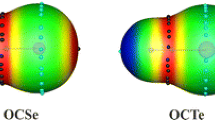Abstract
As a kind of intermolecular noncovalent interaction, chalcogen bonding plays a critical role in the fields of chemistry and biology. In this paper, S⋅⋅⋅S chalcogen bonds in three groups of complexes, F2P(S)N⋅⋅⋅SX2, F2PNS⋅⋅⋅SX2, and F2PSN⋅⋅⋅SX2 (X = F, Cl, Br, OH, CH3, NH2), were investigated at the MP2/aug-cc-pVTZ level of theory. The calculated results show that the formation of S⋅⋅⋅S chalcogen bond is in the manner of attraction between the positive molecular electrostatic potential (VS,max) of chalcogen bond donator and the negative VS,min of chalcogen bond acceptor. It is found that a good correlation exists between the S⋅⋅⋅S bond length and the interaction energy. The energy decomposition indicates the electrostatic energy and polarization energy are closely correlated with the total interaction energy. NBO analysis reveals that the charge transfer is rather closely correlated with the polarization, and the charge transfer has a similar behavior as the polarization in the formation of complex. Our results provide a new example for interpreting the noncovalent interaction based on the σ-hole concept.

The chalcogen bonds in the studied binary complexes are Coulombic in nature, and the charge transfer has a similar behavior as the polarization in the formation of the complex.





Similar content being viewed by others
References
Kabelac M, Hobza PH (2007) Stability of nucleic acid bases and base pairs. Phys Chem Chem Phys 9:903–917
Buckingham AD, Ben JE, Mcdowell SAC (2008) The hydrogen bond. Chem Phys Lett 463:1–10
Wendler K, Thar J, Zahn S, Kirchner BE (2010) The hydrogen bond energy. J Phys Chem A 114:9529
Chudzinski MG, Mcclary CA, Taylor MS (2011) Anion receptors composed of hydrogen- and halogen-bond donor groups: modulating selectivity with combinations of distinct noncovalent interactions. J Am Chem Soc 133:10559–10567
Shokri A, Wang Y, O’doherty GA (2013) Hydrogen-bond networks: strengths of different types of hydrogen bonds and an alternative to the low barrier hydrogen-bond proposal. J Am Chem Soc 135:17919–17924
Elstner M, Hobza P, Frauenheim T (2001) Hydrogen bonding andstacking interactions of nucleic acid base pairs: a density-functional-theory based treatment. J Chem Phys 114:5149–5155
ToriiH YM (2010) Properties of halogen atoms for representing intermolecular electrostatic interactions related to halogen bonding and their substituent effects. J Comput Chem 31:107–116
Xu Z, Liu Z, Chen T (2011) Utilization of halogen bond in lead optimization: a case study of rational design of potent phosphodiesterase type 5 (PDE5) inhibitors. J Med Chem 54:5607–5611
Auffinger P, Hays FA, Westhof E (2004) Halogen bonds in biological molecules. Proc Natl Acad Sci U S A 101:16789–16794
Wilcken R, Zimmermann MO, Lange A (2013) Principles and applications of halogen bonding in medicinal chemistry and chemical biology. J Med Chem 56:1363–1388
Murray JS, Lane P, Clark T (2007) Sigma-hole bonding: molecules containing group VI atoms. J Mol Model 13:1033–1038
Scheiner S (2012) Sensitivity of noncovalent bonds to intermolecular separation: hydrogen, halogen, chalcogen, and pnicogen bonds. CrystEngComm 15:3119–3124
Politzer P, Murray JS, Clark T (2010) Halogen bonding: an electrostatically-driven highly directional noncovalent interaction. Phys Chem Chem Phys 12:7748–7757
Murray JS, Lane P, Clark T, Riley KE, Politzer P (2012) σ-Holes, π-holes and electrostatically-driven interactions. J Mol Model 18:541–548
Esrafili MD, Mohammadian-Sabet F (2015) Pnicogen–pnicogen interactions in O2XP:PH2Y complexes (X=H, F, CN; Y=H, OH, OCH3, CH3, NH2). Chem Phys Lett 638:122–127
Shishkin OV, Omelchenko IV, Kalyuzhny AL (2010) Intramolecular S…O chalcogen bond in thioindirubin. Struct Chem 21:1005–1011
Azofra LM, Alkorta I, Scheiner S (2015) Chalcogen bonds in complexes of SOXY (X, Y = F, Cl) with nitrogen bases. J Phys Chem A119:535–541
Nziko VP, Scheiner S (2014) Chalcogen bonding between tetravalent SF4 and amines. J Phys Chem A 11:10849–10856
Li H, Wu Z, Li D (2015) A singlet thiophosphoryl nitrene and its interconversion with thiazyl and thionitroso isomers. J Am Chem Soc 137:10942–10945
Boys SF, Bernardi F (1970) The calculation of small molecular interactions by the differences of separate total energies. Some procedures with reduced errors. Mol Phys 19:553–566
Frisch MJ, Trucks GW, Schlegel HB, Scuseria GE, Robb MA, Cheeseman JR, Scalmani G, Barone V, Petersson GA, Nakatsuji H, Li X, Caricato M, Marenich A, Bloino J, Janesko BG, Gomperts R, Mennucci B, Hratchian HP, Ortiz JV, Izmaylov AF, Sonnenberg JL, Williams-Young D, Ding F, Lipparini F, Egidi F, Goings J, Peng B, Petrone A, Henderson T, Ranasinghe D, Zakrzewski VG, Gao J, Rega N, Zheng G, Liang W, Hada M, Ehara M, Toyota K, Fukuda R, Hasegawa J, Ishida M, Nakajima T, Honda Y, Kitao O, Nakai H, Vreven T, Throssell K, Montgomery Jr JA, Peralta JE, Ogliaro F, Bearpark M, Heyd JJ, Brothers E, Kudin KN, Staroverov VN, Keith T, Kobayashi R, Normand J, Raghavachari K, Rendell A, Burant JC, Iyengar SS, Tomasi J, Cossi M, Millam JM, Klene M, Adamo C, Cammi R, Ochterski JW, Martin RL, Morokuma K, Farkas O, Foresman JB, Fox DJ (2013) Gaussian 09, revision A.02. Gaussian, Inc., Wallingford
Bulat FA, Toro-Labbe A, Brinck T (2010) Quantitative analysis of molecular surfaces: areas, volumes, electrostatic potentials and average local ionization energies. J Mol Model 16:1679–1691
Schmidt MW, Baldridge KK, Boatz JA (1993) General atomic and molecular electronic structure system. J Comput Chem 14:1347–1363
Weinhold F, Landis CR (2005) Valency and bonding: a natural bond orbital donor-acceptor perspective. Cambridge University Press, Cambridge
Moon J, Baek H, Kim J (2016) Ab initio investigation of the ground states of F2P(S)N, F2PNS, and F2PSN. J Phys Chem A 120:9198–9202
Solimannejad M, Gharabaghi M, Scheiner S (2011) SH…N and SH…P blue-shifting H-bonds and N…P interactions in complexes pairing HSN with amines and phosphines. J Chem Phys 134:024312
Clark T, Hennemann M, Murray JS, Politzer P (2007) Halogen bonding: the σ-hole. J Mol Model 13:291–296
Politzer P, Murray JS, Clark T (2013) Halogen bonding and other σ-hole interactions: a perspective. Phys Chem Chem Phys 15:11178–11189
Bondi (1964) A van der Waals Volumes and Radii. J Phys Chem 68:441–451
Bader RFW (1990) Atoms in molecules-a quantum theory. Oxford University Press, Oxford
Scheiner S (2011) Effects of substituents upon the P…N noncovalent interaction: the limits of its strength. J Phys Chem A 115:11202–11209
Scheiner S (2011) On the properties of X…N noncovalent interactions for first-, second-, and third-row X atoms. J Chem Phys 134:164313
Scheiner S, Adhikari U (2011) Abilities of different electron donors (D) to engage in a P…D noncovalent interaction. J Phys Chem A 115:11101–11110
Kuhne TD, Khaliullin RZ (2014) Nature of the asymmetry in the hydrogen-bond networks of hexagonal ice and liquid water. J Am Chem Soc 136:3395–3399
Politzer P, Murray JS (2017) σ-Hole interactions: perspectives and misconceptions. Crystals 7:212
Politzer P, Murray JS, Clark T (2017) Mathematical modeling and physical reality in noncovalent interactions. J Mol Model 21:52
Clark T, Heßelmann A (2018) The coulombic σ-hole model describes bonding in CX3I⋯Y− complexes completely. Phys Chem Chem Phys 20:22849–22855 and the references cited therein
Clark T, Murray JS, Politzer P (2018) The σ-Hole coulombic interpretation of trihalide anion formation. ChemPhysChem. https://doi.org/10.1002/cphc.201800750
Guo X, An X, Li Q (2015) Se…N chalcogen bond and Se…X halogen bond involving F2C horizontal line Se: influence of hybridization, substitution, and cooperativity. J Phys Chem A 119:3518–3527
Acknowledgments
This work was supported by the National Natural Science Foundation of China (Contract Nos. 21373075, 21371045, 21372062), the Natural Science Foundation of Hebei Province (Contract No. B2016205042).
Author information
Authors and Affiliations
Corresponding author
Additional information
Publisher’s Note
Springer Nature remains neutral with regard to jurisdictional claims in published maps and institutional affiliations.
Electronic supplementary material
ESM 1
(DOCX 767 kb)
Rights and permissions
About this article
Cite this article
Yan, N., Huo, S., Li, X. et al. The chalcogen bond in F2P(S)N⋅⋅⋅SX2, F2PNS⋅⋅⋅SX2, F2PSN⋅⋅⋅SX2 (X = F, Cl, Br, OH, CH3, NH2) complexes. J Mol Model 25, 19 (2019). https://doi.org/10.1007/s00894-018-3895-1
Received:
Accepted:
Published:
DOI: https://doi.org/10.1007/s00894-018-3895-1




